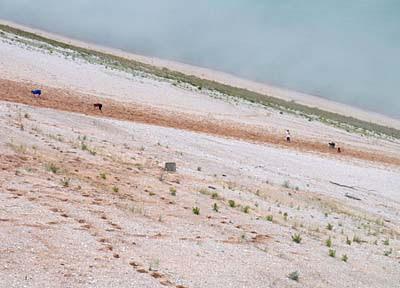 |
Large dune in fog on the shore of Lake Michigan
at Sleeping Bear Dune National Lakeshore |
Anishinaabek Indian legend has it that long ago, in the
land that is now Wisconsin, a mother bear and her two cubs plunged into Lake
Michigan to avoid a raging forest fire. As
they swam and swam, the cubs became tired and lagged far behind. Mother bear finally reached the opposite
shore in Michigan and climbed to the top of a bluff to watch and wait for her
cubs. But the cubs didn’t make it. Today “Sleeping Bear,” a solitary dune over-looking
Lake Michigan, marks the spot where mother bear waited. Her lost cubs are the two Manitou islands
just off shore.
 |
| Crazy people crawling up the really steep dune in the fog |
This American Indian story may have been the first
explanation of how the large sand dunes and other features of the land near
Sleeping Bear were created. In more
recent times scientists have followed geologic clues to explain the complex
landscape. First, shallow warm seas
covered the area followed by the powerful earth-moving forces of glaciers, wind
and water. Glaciers left behind a sandy
coast on the windward side of Lake Michigan and the prevailing westerly winds
and lake waters did the rest.
 |
| Basswood tree struggling to keep rooted in the ever-shifting sands |
Much of the land around the Great Lakes has this ‘dune
and swale’ landscape formation of beach dunes with narrow swales separating the
dunes. The swales are wetlands containing
pools with grasses, sedges and ferns.
This is ideal habitat for migrating and nesting birds.
Sleeping Bear Dunes National Lakeshore, managed by the
National Park Service, has some of the largest dunes in the Great Lakes. The park’s namesake, Sleeping Bear Dune, is
actually a glacially formed bluff topped by sand that towers over 400 feet
above Lake Michigan.
 |
| Young and old alike enjoy the 'Dune Climb' in their own way |
We learned all this cool stuff on the Pierce Stocking
Scenic Drive that we took our first afternoon in the park. It was still cloudy and foggy with visibility
only about half a mile or less so Sleeping Bear Dune and Lake Michigan were nowhere
to be seen. But we could learn about
them, imagine what they would look like and see some of the other sites on the
scenic drive. One spot in the Sleeping
Bear Complex of dunes, the Dune Climb, was easily accessible so we could see
all the people climbing that dune.
 |
Lake Michigan with Sleeping Bear Dune in the distance
Sun makes all the difference! |
The next morning David came in from his early walk with
Maya and woke me with the news that the sun was out. We quickly had breakfast, fixed a lunch to
put in our packs and headed out for a hike to Lake Michigan. It was a glorious day – crisp, clear and
cool. We hiked through shady beech-maple
forests to the open, sunny dunes and yes, a view of deep blue Lake Michigan
with Sleeping Bear Dune in the distance. I guess there is nothing like a few days of
damp foggy weather to make a clear sunny day seem even more beautiful.
 |
| Lake Michigan in fog |
 |
| Same place, next day -- what a difference! |
We have one last stop to make on the shores of Lake
Michigan at Wilderness State Park on the very tip of the ‘mitten.’ A few days in this park near Mackinaw City and
then it is on to the U.P. or Upper Peninsula to spend a couple of weeks.
 |
Dune erosion at work
Pyramid Point |
David’s Stats:
Days
Hiked: 1
Total Miles Hiked: 5.64
Total Elevation Gain: 967










No comments:
Post a Comment